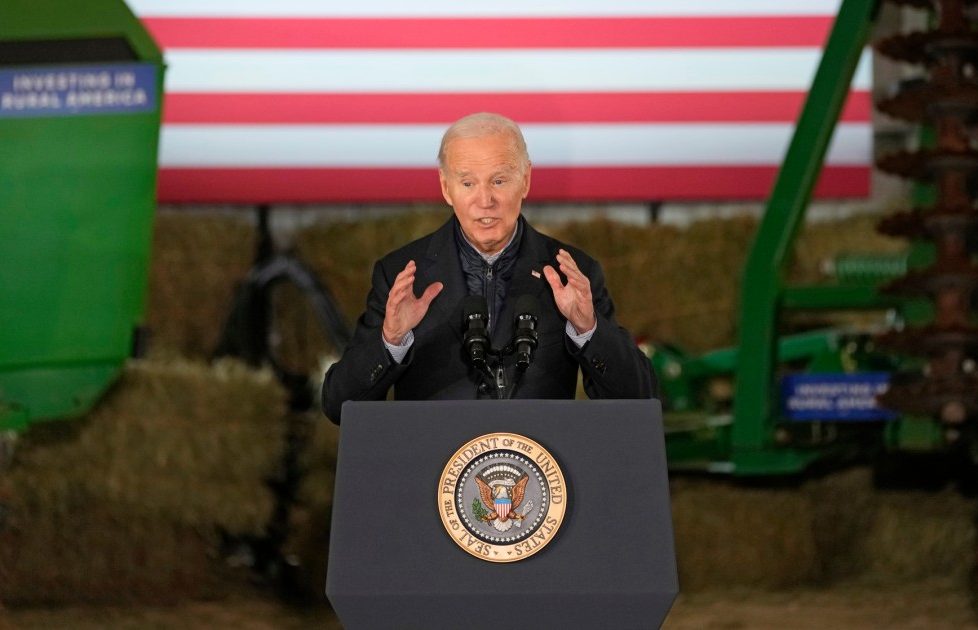Rural voters continue to evade Democrats

NORTHFIELD, Minn. — Dairy farmers Steven and Jodi Ohlson Read have heard what others in their rural Minnesota community think about the economy, griping about inflation and rising costs.
But while they acknowledge that small farms have felt the economic impacts of the last few years very acutely, the pair went to see President Joe Biden speak on Wednesday in their hometown because they think he’s the one on the right track.
“Despite what everyone is saying, the economy’s been humming along pretty well,” Steven Read said. “I don’t blame Biden for inflation. I blame corporate greed.”
Still, the improving economy remains a tough sell for Biden to rural voters, who already are voting in larger numbers for Republicans.
Over the past two years, inflation has hit rural households harder than the rest of the country. According to researchers at Iowa State University, rural households had to pay an extra $8,120 due to inflation in 2021 and 2022, more than the $7,480 paid by urban households in the same two years. Meanwhile, researchers at Cornell University estimate that 94% of the nation’s job growth since 2000 happened in urban counties.
According to Pew Research, former President Donald Trump was able to win 65% of the rural vote in 2020, up from 59% in 2016, pulling more away than Mitt Romney did in 2012. Republican candidates raked in 69% of the rural vote in the 2022 midterms.
And recent polling shows that the trend isn’t getting any better. An NBC News poll from September 2023 shows that President Biden has a 51% approval rating among urban voters, but just 26 % approval among rural voters. That same poll also showed that 57% of urban voters were satisfied with their own financial situation, compared to just 42 % of rural voters.
Rural voters are often more socially conservative, so Democrats’ leftward push may have contributed to rural voters swinging more decisively for Republicans, explained University of Minnesota Morris professor Tim Lindberg.
During the 2016 election, rural areas of Midwestern states shifted “severely” to the GOP, Lindberg said, pointing to trends in Michigan, Wisconsin and Minnesota.
“The question, of course, in 2016, was, would that stick?” Lindberg said. “Would that stick after Trump was no longer on the ballot? And we see evidence that in 2018, and even in 2020, that it did have a lot of sticking power.”
Biden has long tried to make central to his pitch an understanding of the plight of the working class. This week, he touted $5 billion in new federal funding for agricultural communities as he kicked off a two-week blitz aimed at winning back rural voters who have increasingly turned away from Democrats in recent years.
“It’s about making things in rural America again,” Biden told a crowd inside the chilly barn in Northfield — some 30 miles outside Minneapolis. “Right now, the farmers and ranchers who actually grow the food only see a small percentage of the profit when the food is sold.”
As Biden renewed his push to sell “Bidenomics,” the president stressed that the unemployment rate has stayed under 4% for 20 months. He pointed to clean energy initiatives in the Inflation Reduction Act as benefiting farmers and ranchers, and the White House emphasized that the new federal funding would help create jobs, connect more rural areas to broadband and promote farming techniques that fight climate change.
“A year ago, experts said a recession was almost guaranteed,” Biden said. “Well, guess what? Just last week, we learned the economy grew by nearly 5%.”
Over the next two weeks, the White House said the president as well as Cabinet secretaries and other senior administration officials would fan out across the country to keep selling that message. Meanwhile, the Democratic National Committee has a designated Rural Council chair, a DNC source said, adding that during the 2022 midterms, the DNC Rural Strong signature program worked with organizers on the ground in nearly 40 states.
But at his farm in Collins, Iowa, Dave Struthers is skeptical. The pork producer said these last few years have been a struggle.
“We’ve had higher costs and our product we produce has not risen in value correspondingly,” Struthers said. “We’re the people that produce the food and manufacture a lot of the goods that the people on the coasts need every single day and we seem to be ignored just because we don’t have the population.”
Struthers said he was frustrated that the Biden administration had not done more to grow the biodiesel industry — and he also felt the president was pushing electric vehicles too much. He said he planned to vote for Trump in next year’s election,
“He’s not my favorite due to some personal issues of his, but I would support him,” Struthers said. “I believe Republicans have understood the cost of regulations, the burdens of unnecessary regulations, and it seems the Democrats have always wanted to regulate and have their fingers in everything.”
